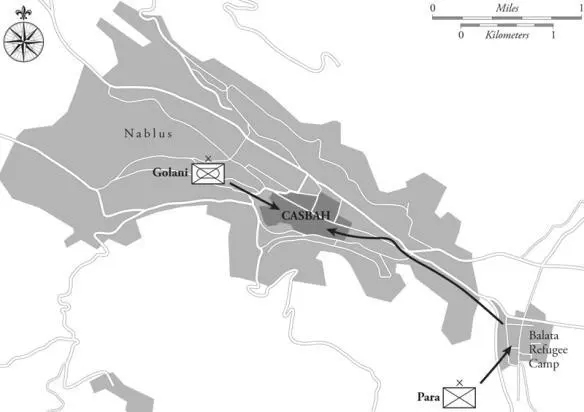A different, but no less effective approach was used by the paratroopers. Though they had access to attached mechanized infantry, tanks and dozers, the paratroopers as a standard did not have the firepower or armored protection of the mechanized infantry so they could not use the same tactics. The paratroopers advanced using tried and true urban fighting techniques. As a tactical standard they refused to recognize and use windows and doors, and instead advanced primarily through the interior spaces of adjoining buildings. The paratrooper technique was to create mouse holes between buildings using explosives or pick axes, and move by squads along multiple planned routes, each route planned through a series of adjoining buildings. Stairs were also avoided and the troops moved between floors by blasting holes through floors and ceilings. The goal of the paratrooper advance was to reach their objective without ever appearing on the open street or alley. The paratroopers also employed their snipers to great effect. The snipers, firing from concealed positions and great distances, picked off targets as the advancing infantry forced the defending Palestinians to retreat or reposition.
As the Palestinian militants lost men and were gradually forced back they were equally frustrated by their losses and their inability to inflict any significant damage on the attacking IDF forces. Finally, in the face of dwindling resources, lack of success, and mounting casualties, the Palestinian groups in the casbah surrendered. The IDF suffered only one casualty in the battle and that was due to friendly fire. The Palestinian defenders lost approximately 70 fighters. Most surprising, given that intense combat in the midst of a large civilian population continued for five days, was the lack of significant collateral damage. Only eight civilians were killed in the fighting in Nablus, and despite employing bulldozers, tanks, and demolitions, only four buildings were completely destroyed, though hundreds were significantly damaged. The IDF took several hundred prisoners in the battle and killed or arrested numerous top-level experienced militant leaders.
Operation against militants in Jenin began on April 2, the day before the attack at Nablus, with IDF forces moving into the city and sealing it off from outside communications and support. Of the two cities, the IDF analysis was the Jenin operation would be the easier to accomplish: the city was not nearly as big as Nablus, it was very close to the Israeli border, the refugee population was less than half the size of that in Nablus, and all the refugees were located in a single camp. Because of these considerations, the forces assigned to Jenin were not as robust: the mission was assigned to a reserve division commanding the 5th Reserve Infantry Brigade, reinforced by a battalion from the Golani Brigade as well as special forces, armor, and engineers.
The IDF forces operating in Jenin were organized under Reserve Division No. 340 under the command of Brigadier General Eyal Shlein. The 5th Reserve Infantry Brigade and a battalion of the Golani Brigade occupied the city of Jenin on April 2, 2002, and by the end of the first day they had the bulk of the city under control. That was the prelude to the major part of the operation which was to move into and establish control of the Jenin Refugee Camp. The Jenin Refugee Camp was located in the southwest portion of the city; it was only about 0.5km 2(one-fifth square mile). Access into the refugee camp was carefully controlled by a consortium of Palestinian militant groups who had erected barricades and checkpoints on every avenue into the camp. On April 2, using loudspeakers, the IDF broadcast its intention to occupy the camp and requested all civilians leave the area of military operations. Most of the camp’s 16,000 residents chose to evacuate the camp, however many did not leave until the lead army units began to move into the area. Still, 1,000–4,000 civilians remained in the camp throughout the fighting, alongside several hundred dedicated militant fighters.
The several hundred fighters in the city of Jenin were different from any other group of fighters yet met by the Israelis during Operation Defensive Shield. Though, like the militants in the other cities, they comprised members of Al Aqsa Martyrs’ Brigade, Islamic Jihad, Hamas, and the Palestinian Authority security forces, this group within Jenin decided to subordinate themselves to a unified command inside the camp. This unusual situation was due to the presence of Abu Jandal, who was a uniquely capable and charismatic leader. He was a veteran of the Iraqi army, had fought in Southern Lebanon, and was the leader of the coalition of the various militant groups in Jenin. He understood that though it was impossible to beat the Israelis militarily, it was very possible to achieve a strategic political victory in Jenin, while losing the tactical battle in the camp. To do this they needed to make the taking of the camp a lengthy, and most importantly, casualty-producing battle for the IDF.
On April 3, after completely isolating the city from all outside communications and access, including ensuring that no media organizations had access to the operation, the IDF entered the camp. The 5th Brigade moved into the camp slowly and methodically from the northeast. They were very wary of exposing themselves to casualties. Many of the reservists were less than enthusiastic about being called to active service with no notice, and some disagreed with the political policy behind the operation. They were also nervous because they had almost no training in urban warfare techniques. At Nablus a reserve tank crew had refused to obey orders to attack into the city because they felt unprepared for urban battle. A brigade commander eventually convinced the soldiers to go into battle. At Jenin there were no combat refusals, but the 5th Brigade’s officers were very conscious of the soldiers’ lack of training in urban combat. The brigade also had leadership challenges. The brigade commander had only taken command of the brigade a few days before the operation began. On the first day of operations in the city a very experienced company commander was killed by a militant. This resulted in the officers approaching the battle with even more caution than usual, and the 5th Brigade advanced slowly and methodically throughout the battle.
As the 5th Brigade moved slowly and steadily to breach the perimeter of the camp, the IDF complicated the defenders’ problems by launching another attack from the southwest. This attack was conducted by Battalion 51 of the Golani Brigade. In addition, a company from the Nahal Brigade attacked the camp from the southeast. Both of the main attacks, the 5th Brigade and the attack of Battalion 51, were supported by special forces and air force Apache attack helicopter. Elements of the elite Shayetet 13 (naval commandos) and Duvdevan (counterterrorist commandos) special forces units were operating in the city as well. However, jet aircraft support and artillery support, as in Nablus, were prohibited.
9.2 The IDF Attacks Nablus, April 2002

IDF special forces conducted two broad types of missions in the urban fight. One type of mission was in direct support of the attacking conventional infantry brigade. In that role the special forces would overwatch the regular infantry and armor movement with snipers. Typically, snipers were deployed in a good vantage point 500 meters (1,640ft) or more to the rear of the conventional troops moving forward. From their position they were able to engage any opposing snipers or gunmen firing at the conventional force. They were also in an ideal position to engage any militants attempting to flee in front of the conventional infantry attack. This type of mission was conducted by either an elite army-level special forces unit or, more typically, the brigade reconnaissance company which was an elite unit in all Israeli brigades and had special forces training and capabilities.
Читать дальше













